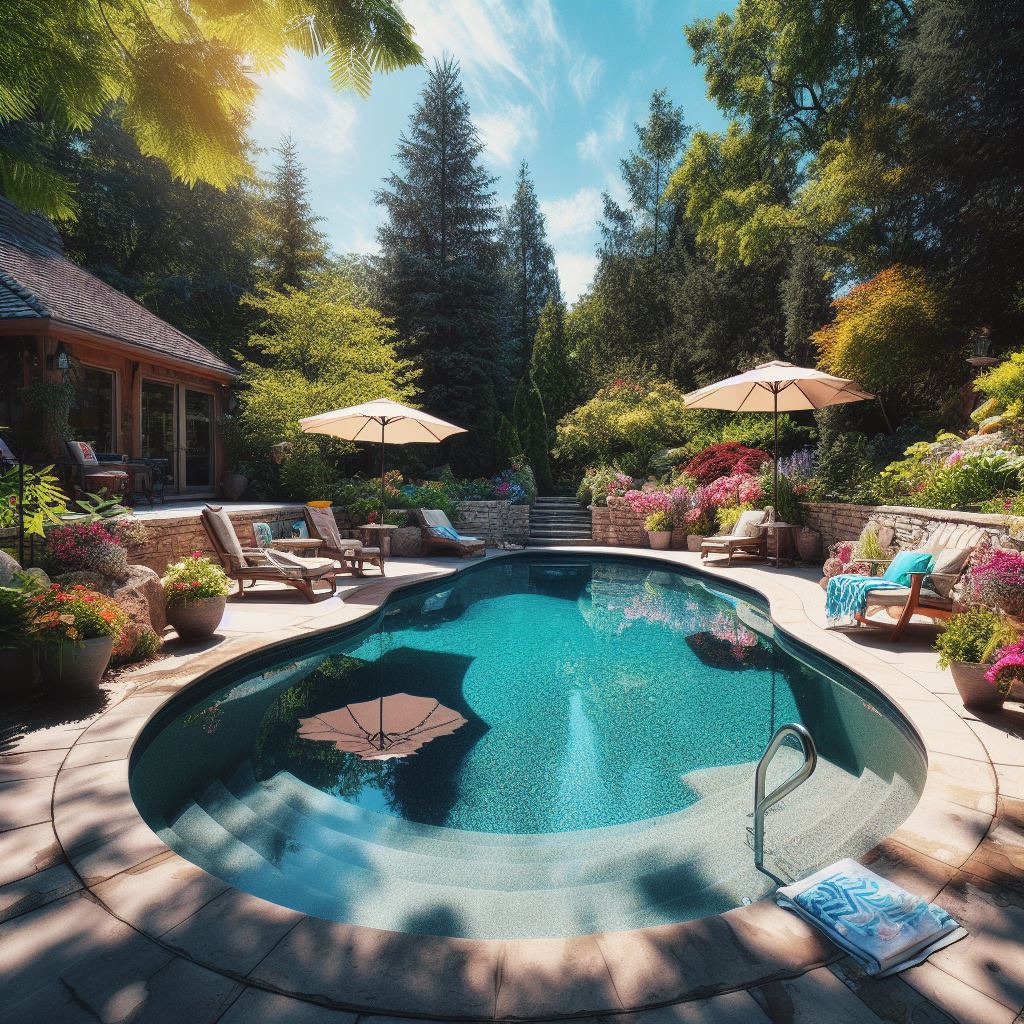Did you ever wander how to calculate your pool evaporation rate? Pool ownership is a joy for homeowners, providing a refreshing refuge for leisure and pleasure. Water evaporation is an inevitable process in maintaining a swimming pool. While some level of evaporation is natural, excessive loss of pool water can lead to various issues, including higher water bills and an increased need for chemical adjustments. However, the joy of pool ownership is accompanied by the obligation of care, and one component that is sometimes disregarded is water evaporation. In this thorough post, we’ll look deeper into the variables that contribute to pool water evaporation, its impact, and effective management and reduction measures.

Factors Influencing Pool Water Evaporation
Environmental Conditions
- Temperature: It’s no surprise that higher temperatures lead to increased evaporation rates. Pools located in regions with scorching summers often experience more significant water loss. Managing your pool’s water level during heatwaves is crucial.
- Wind: Windy conditions can enhance evaporation by facilitating the transfer of water vapor from the pool’s surface into the air. Pool owners in windy areas may need to be especially vigilant in managing water loss.
- Humidity: The relative humidity of the surrounding environment plays a significant role in evaporation. Lower humidity levels result in faster evaporation. Pool owners in arid climates are more prone to high evaporation rates and must adopt appropriate strategies.
Pool-Specific Factors
- Pool Size: The size of your pool matters. Larger pools have more surface area exposed to the air, making them more susceptible to water loss. Smaller pools experience proportionally less evaporation.
- Water Temperature: Heated pools, while providing comfort, experience higher evaporation rates than cooler pools. Maintaining an energy-efficient temperature range can help mitigate this effect.
- Water Features: Pools with fountains, waterfalls, and other water features have increased exposed water surface, promoting evaporation. Managing when and how these features operate can influence water loss.
Calculate Pool Water Evaporation Rate
Step 1: Measure Water Loss
To calculate the evaporation rate, you’ll need to measure the water loss over a specific period. Follow these steps:
- Choose a Standard Unit: Decide on a standard unit of measurement (e.g., inches or centimeters) to monitor water level.
- Mark the Water Level: Use a water-resistant marker or adhesive tape to mark the pool’s water level.
- Record Initial Measurement: Record the initial measurement. This will serve as your baseline.
- Wait for the Designated Time: Allow a specific period (e.g., 24 hours) to pass while avoiding activities like swimming that can influence the water level.
- Record Final Measurement: After the designated time, measure the water level again.
Step 2: Calculate Pool Evaporation Rate
Now that you have both the initial and final measurements, follow this formula to calculate the water evaporation rate:
Evaporation Rate (inches per day) = (Initial Measurement – Final Measurement) / Time (in days)
For example, if your initial measurement was 60 inches, the final measurement was 58 inches, and the designated time was 1 day, the calculation would be:
Evaporation Rate = (60 inches – 58 inches) / 1 day = 2 inches per day

Strategies to Manage Pool Water Evaporation
Pool Covers
- Solar Covers: Solar covers not only reduce evaporation but also help retain heat, making them a double benefit for pool owners. They’re an investment that pays for itself in lower water and energy bills.
- Safety Covers: While primarily designed for safety, these covers also inhibit evaporation. Pool owners who wish to prevent water loss may consider installing a safety cover.
Windbreaks and Landscaping
Windbreaks, such as trees or bushes, can be strategically planted to prevent wind-induced evaporation. These natural barriers decrease the pool’s wind exposure, so minimizing water loss.
Managing Water Features
While water features like fountains and waterfalls enhance the aesthetics of your pool, they also increase evaporation. Use these features strategically by reducing their operation during high evaporation conditions.
Efficient Filtration
Ensuring your pool filtration system operates efficiently is crucial. Clean or backwash the filter as needed to maintain a good water flow rate. Efficient filtration minimizes the need for excessive refilling.
Monitoring
Keep a close eye on your pool’s water level. If you notice significant water loss beyond the expected evaporation rate, investigate potential issues, such as leaks. Early detection can save you money and prevent water waste.
Water-Saving Technologies
Consider investing in technologies that help reduce water loss, such as pool covers, water recycling systems, and backwash minimization systems. While these technologies have an upfront cost, they offer long-term water and cost savings.
Weather-Based Adjustments
Adjust pool-related activities based on weather conditions. For example, avoid heating the pool on extremely hot days to reduce evaporation. Being proactive about weather-based adjustments can significantly impact your water loss.
Final Thoughts
Water evaporation is an inevitable aspect of pool ownership, but understanding and calculating its rate can help you manage it effectively. By monitoring and addressing the factors contributing to evaporation, you can enjoy your pool while conserving resources and reducing costs. Remember to implement practical strategies and use technology to your advantage to make the most of your pool while keeping water loss in check.
By implementing a combination of these strategies you can enjoy your pool while keeping water loss to a minimum. Remember, a well-maintained pool is not just about its water quality and aesthetics but also about responsible water management. By taking these steps, you’ll not only save money but also contribute to a more sustainable and environmentally conscious approach to pool ownership.

